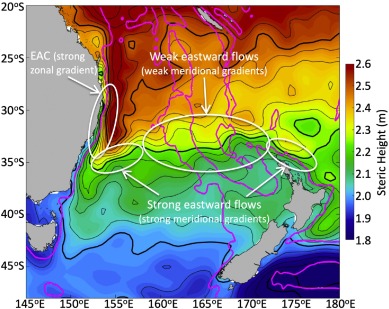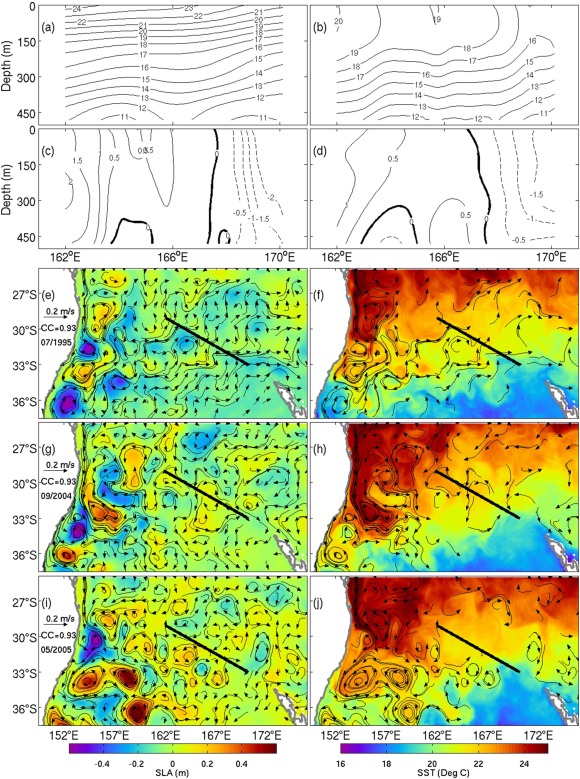The traditional view of the circulation in the Tasman Sea includes a coherent, eastward flow from eastern Australia towards the northern tip of New Zealand. This flow is widely referred to as the Tasman Front. The Tasman Front was first suggested in the 1960s by oceanographers reasoning that the source of volume transport “feeding” the East Auckland Current, around northern New Zealand and extending down the east coast, must be off eastern Australia.
However, the first reported in situ measurements of the Tasman Front included hand-drawn temperature sections that highlighted features that are not supported by observations.
Here, we objectively map the original data, showing that the published reports of strong, sub-surface, north-south temperature gradients were unjustified.
In the absence of additional observations, we can’t be sure of the context of those original measurements – so we have objectively “searched” fields in a recent 25-year ocean reanalysis to identify scenarios that are consistent with the observations.

Figure1: Time-mean steric height relative to 2000 m depth from the CSIRO Atlas of Regional Seas (CARS; in colour), with the 1500 m bathymetry line overlaid (in magenta) to show the location of the Lord Howe Rise and other intermediate-depth topographic features. The different regions of the Tasman Sea described in the text are also labelled here
We suggest that the most likely interpretation of the original data, is that they measured an eddy field – or a series of discontinuous streams across the central Tasman Sea. We also analyse data from surface drifting buoys to show that water traversing the Tasman Sea may take several different paths.
We conclude that a continuous, zonal, eastward flow across the Tasman Sea is less common than widely-accepted conceptual models imply. Instead, we suggest that the eastward flow between Australia and northern New Zealand is perhaps better described as an “eastern extension of the EAC” – since this doesn’t imply the presence of a front, and doesn’t preclude a broad flow. For clarity, we also suggest that the southern branch of the EAC, known as the EAC extension, should be referred to as the “southern extension of the EAC”.

Figure 2: Comparison of (a,c) observations in April 1973 and (c,d) the Bluelink ReANalysis (BRAN) fields in July 1995 (the best match to observations). For these comparisons, in (e-f) July 1995, (g-h) September 2004, and (i-j) May 2005, the anomaly correlation between the observed and reanalysed temperature anomalies are of 0.93. Maps of BRAN (e,g,i) sea level anomaly and (f,h,j) sea surface temperature, with surface velocities overlaid, are intended to provide context for the possible broader-scale circulation for the observations. Vectors are only shown for locations where current speed exceeds 0.05 m/s in panel (e,g,i) and 0.2 m/s in panel (f,h,j) – to highlight the areas of stronger velocities.
The perception of the presence of a strong, persistent front – separating the warm Coral Sea waters and the cold Tasman Sea waters – would likely influence many hypothesis about the regional ocean circulation, the biological behaviour in the Tasman Sea, and many operational (e.g., shipping, defence, search and rescue) and recreational (sailing) activities in the region. It therefore seems important to recognise that there is not an ever-present, distinct front that some might expect.
- Paper: Peter R. Oke, Gabriela S. Pilo, Ken Ridgway, Andrew Kiss, Tatiana Rykova, A search for the Tasman Front, Journal of Marine Systems, Volume 199, 2019, 103217, ISSN 0924-7963, https://doi.org/10.1016/j.jmarsys.2019.103217
